Abstract
Recent reports of a pertussis-toxin (Ptx)-sensitive inhibition of glucose-induced insulin release by prostaglandin E2 (PGE2) in transformed beta-cells prompted us to look for the presence of prostaglandin-regulatable GTP-binding proteins (G-proteins) on the secretory granules of normal pancreatic islets. PGE2 (but not PGF2 alpha, PGA2, PGB2 or PGD2) stimulated in a concentration-dependent manner a high-affinity GTPase activity in the secretory-granule-enriched fractions of both normal rat and human islets. Similar results were found after sucrose-density-gradient-centrifugation-based isolation of secretory granules to those after a differential-centrifugation procedure. Half-maximal stimulation occurred at 800 nM PGE2, a concentration known to inhibit both phases of glucose-induced insulin secretion from pure beta-cell lines. The GTPase stimulatory effect of PGE2 was blocked virtually totally by Ptx pretreatment; it was not due to an effect on substrate binding since no measurable effect of PGE2 on binding of guanosine 5'-[gamma-[35S]thio]triphosphate was observed in cognate fractions. Other Ptx-sensitive inhibitors of insulin secretion (such as adrenaline or clonidine) also stimulated GTPase activity, suggesting that one (or more) inhibitory exocytotic G-proteins (i.e. a putative GEi) is located on the secretory granules. These studies demonstrate, for the first time in an endocrine gland, the presence of a regulatable G-protein, strategically located on the secretory granules where it might regulate the exocytotic cascade distal to both plasma-membrane events and the generation of soluble mediators of insulin secretion.
Full text
PDF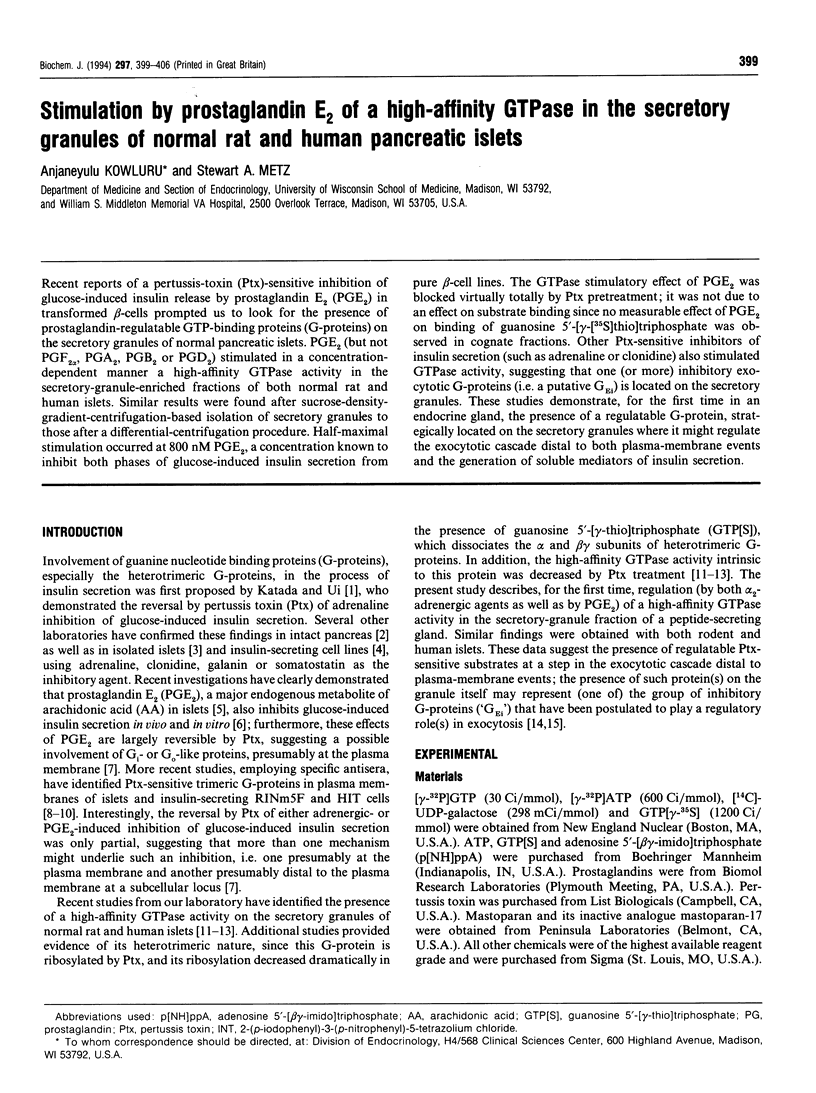
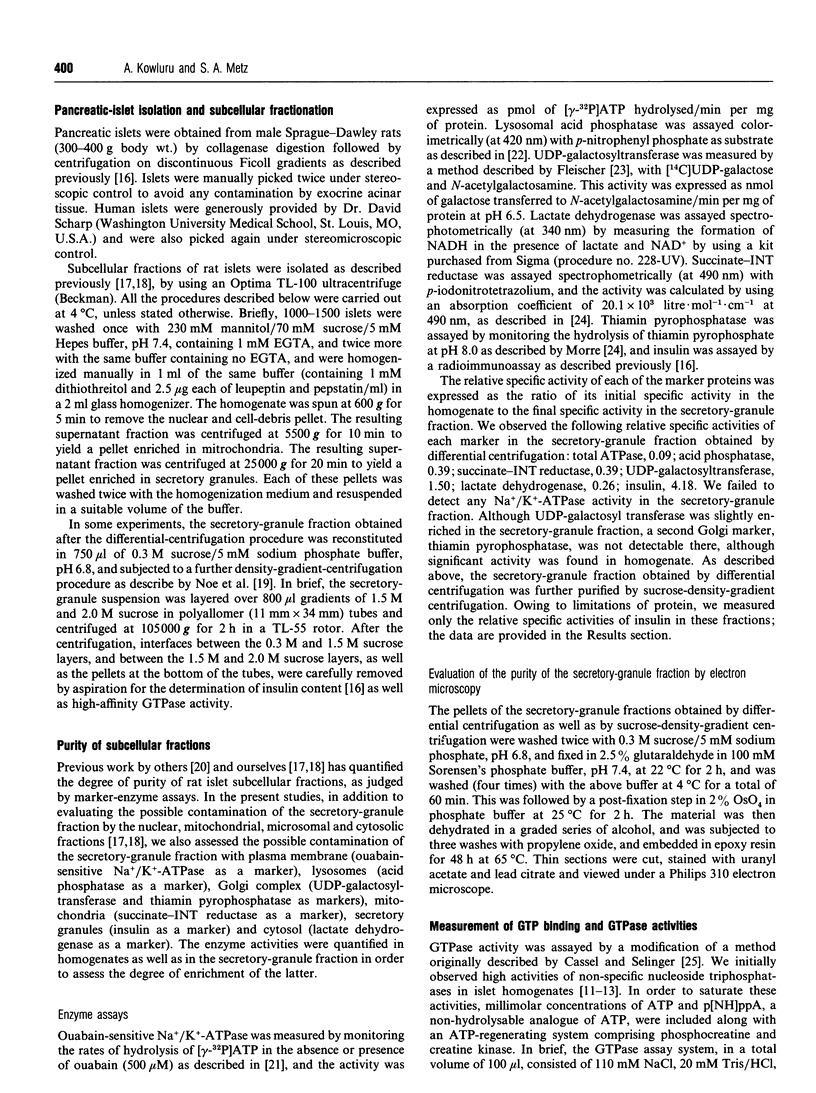
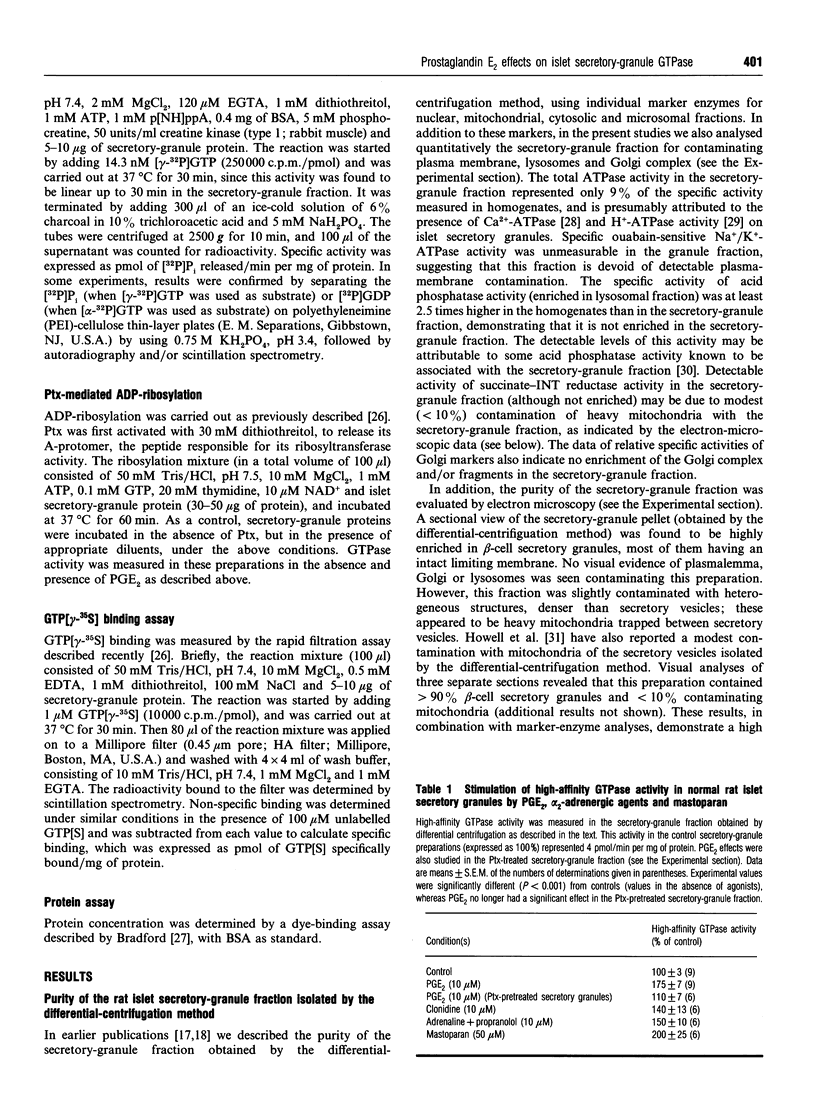
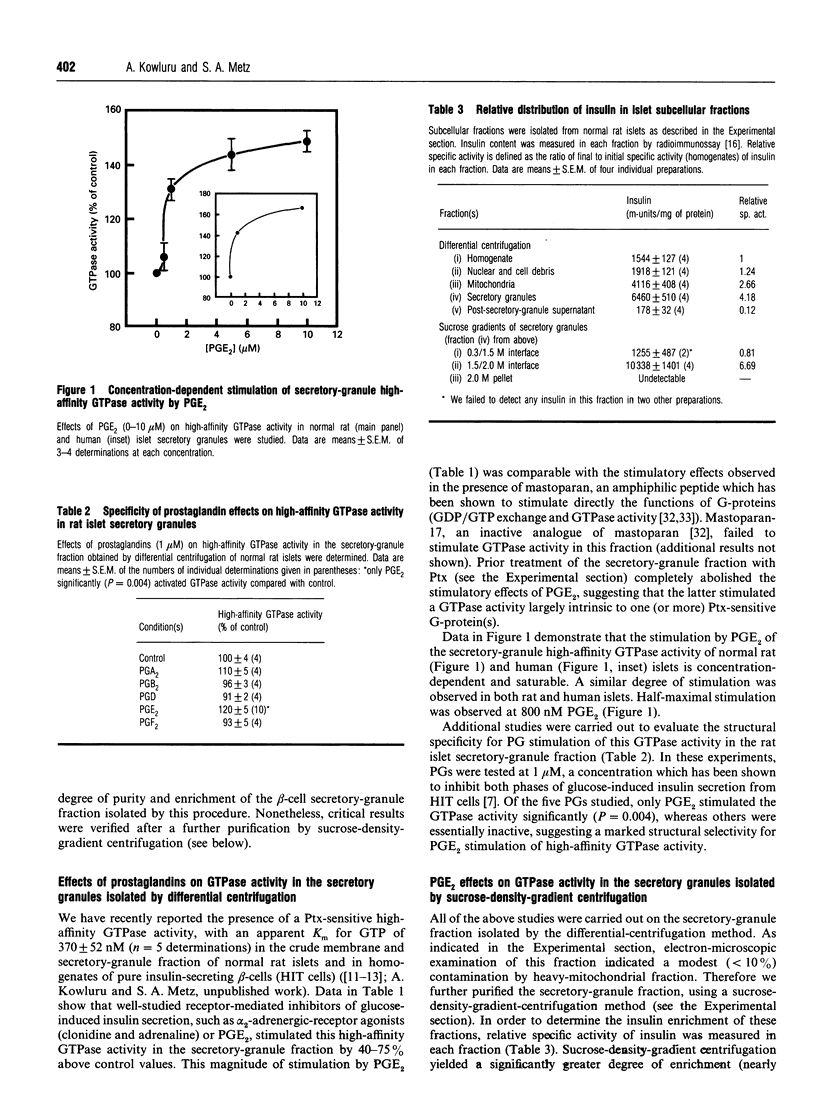
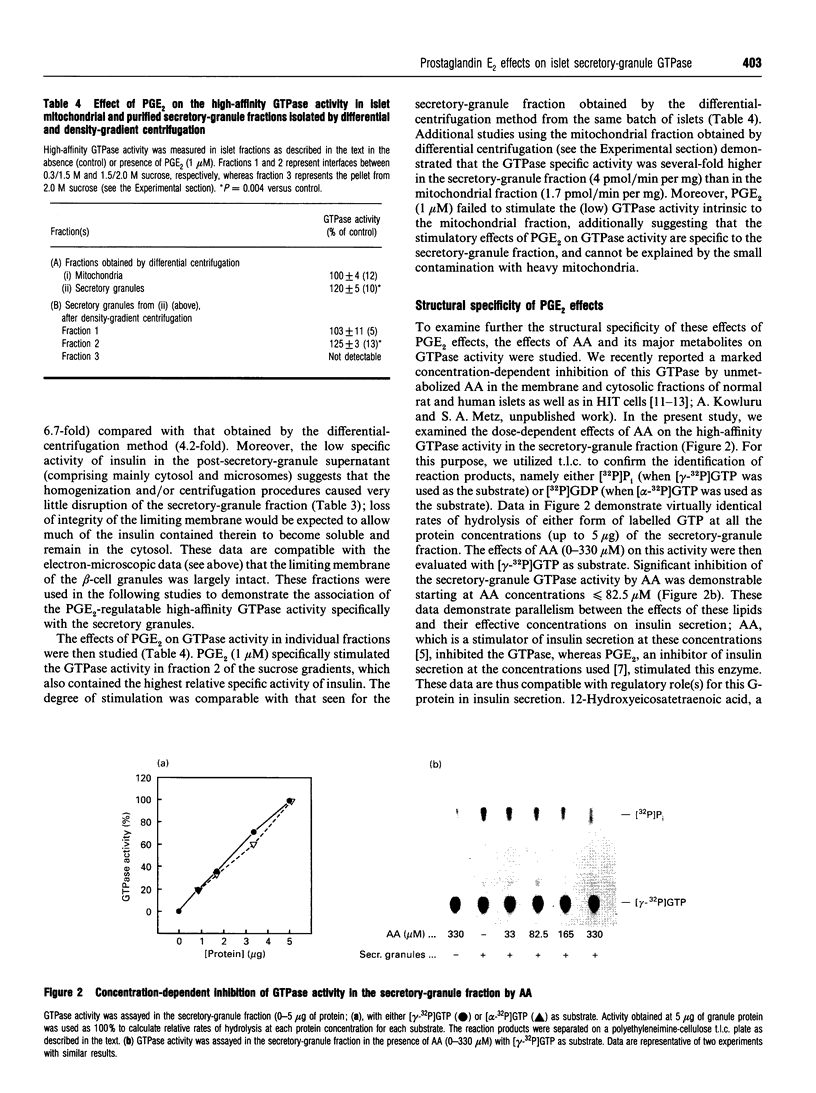

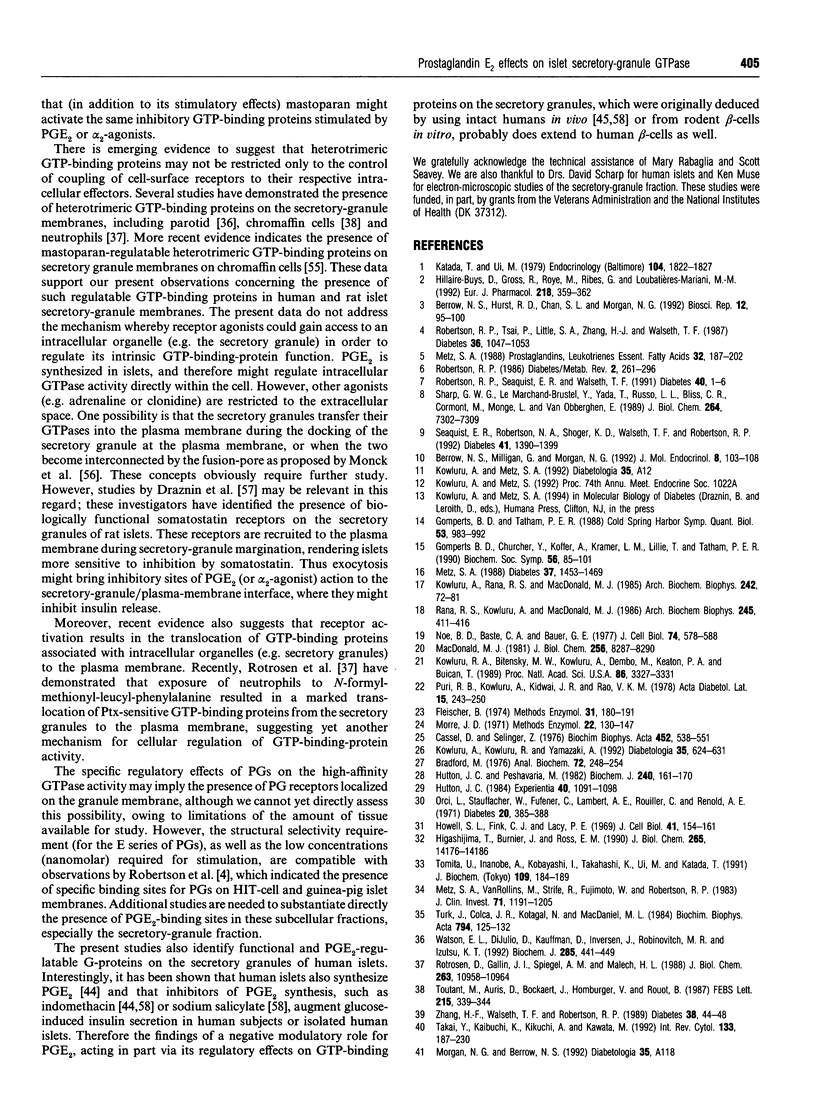

Images in this article
Selected References
These references are in PubMed. This may not be the complete list of references from this article.
- Berrow N. S., Hurst R. D., Chan S. L., Morgan N. G. Immunoprecipitation of a pertussis toxin substrate of the G(o) family from rat islets of Langerhans. Biosci Rep. 1992 Apr;12(2):95–100. doi: 10.1007/BF02351213. [DOI] [PubMed] [Google Scholar]
- Berrow N. S., Milligan G., Morgan N. G. Immunological characterization of the guanine-nucleotide binding proteins Gi and Go in rat islets of Langerhans. J Mol Endocrinol. 1992 Apr;8(2):103–108. doi: 10.1677/jme.0.0080103. [DOI] [PubMed] [Google Scholar]
- Bourne H. R., Sanders D. A., McCormick F. The GTPase superfamily: a conserved switch for diverse cell functions. Nature. 1990 Nov 8;348(6297):125–132. doi: 10.1038/348125a0. [DOI] [PubMed] [Google Scholar]
- Bradford M. M. A rapid and sensitive method for the quantitation of microgram quantities of protein utilizing the principle of protein-dye binding. Anal Biochem. 1976 May 7;72:248–254. doi: 10.1016/0003-2697(76)90527-3. [DOI] [PubMed] [Google Scholar]
- Cassel D., Selinger Z. Catecholamine-stimulated GTPase activity in turkey erythrocyte membranes. Biochim Biophys Acta. 1976 Dec 8;452(2):538–551. doi: 10.1016/0005-2744(76)90206-0. [DOI] [PubMed] [Google Scholar]
- Draznin B., Leitner J. W., Sussman K. E. A unique control mechanism in the regulation of insulin secretion. Secretagogue-induced somatostatin receptor recruitment. J Clin Invest. 1985 May;75(5):1510–1516. doi: 10.1172/JCI111855. [DOI] [PMC free article] [PubMed] [Google Scholar]
- Fleischer B. Isolation and characterization of Golgi apparatus and membranes from rat liver. Methods Enzymol. 1974;31:180–191. doi: 10.1016/0076-6879(74)31020-8. [DOI] [PubMed] [Google Scholar]
- Gomperts B. D., Churcher Y., Koffer A., Kramer I. M., Lillie T., Tatham P. E. The role and mechanism of the GTP-binding protein GE in the control of regulated exocytosis. Biochem Soc Symp. 1990;56:85–101. [PubMed] [Google Scholar]
- Gomperts B. D., Tatham P. E. GTP-binding proteins in the control of exocytosis. Cold Spring Harb Symp Quant Biol. 1988;53(Pt 2):983–992. doi: 10.1101/sqb.1988.053.01.113. [DOI] [PubMed] [Google Scholar]
- Gross R. W., Ramanadham S., Kruszka K. K., Han X., Turk J. Rat and human pancreatic islet cells contain a calcium ion independent phospholipase A2 activity selective for hydrolysis of arachidonate which is stimulated by adenosine triphosphate and is specifically localized to islet beta-cells. Biochemistry. 1993 Jan 12;32(1):327–336. doi: 10.1021/bi00052a041. [DOI] [PubMed] [Google Scholar]
- Han J. W., McCormick F., Macara I. G. Regulation of Ras-GAP and the neurofibromatosis-1 gene product by eicosanoids. Science. 1991 Apr 26;252(5005):576–579. doi: 10.1126/science.1902323. [DOI] [PubMed] [Google Scholar]
- Higashijima T., Burnier J., Ross E. M. Regulation of Gi and Go by mastoparan, related amphiphilic peptides, and hydrophobic amines. Mechanism and structural determinants of activity. J Biol Chem. 1990 Aug 25;265(24):14176–14186. [PubMed] [Google Scholar]
- Hillaire-Buys D., Gross R., Roye M., Ribes G., Loubatières-Mariani M. M. Adrenergic inhibition of insulin secretion involves pertussis toxin-sensitive and -insensitive mechanisms. Eur J Pharmacol. 1992 Aug 6;218(2-3):359–362. doi: 10.1016/0014-2999(92)90193-8. [DOI] [PubMed] [Google Scholar]
- Howell S. L., Fink C. J., Lacy P. E. Isolation and properties of secretory granules from rat islets of Langerhans. I. Isolation of a secretory granule fraction. J Cell Biol. 1969 Apr;41(1):154–161. doi: 10.1083/jcb.41.1.154. [DOI] [PMC free article] [PubMed] [Google Scholar]
- Hutton J. C., Peshavaria M. Proton-translocating Mg2+-dependent ATPase activity in insulin-secretory granules. Biochem J. 1982 Apr 15;204(1):161–170. doi: 10.1042/bj2040161. [DOI] [PMC free article] [PubMed] [Google Scholar]
- Hutton J. C. Secretory granules. Experientia. 1984 Oct 15;40(10):1091–1098. doi: 10.1007/BF01971456. [DOI] [PubMed] [Google Scholar]
- Katada T., Ui M. Effect of in vivo pretreatment of rats with a new protein purified from Bordetella pertussis on in vitro secretion of insulin: role of calcium. Endocrinology. 1979 Jun;104(6):1822–1827. doi: 10.1210/endo-104-6-1822. [DOI] [PubMed] [Google Scholar]
- Kowluru A., Kowluru R. A., Yamazaki A. Functional alterations of G-proteins in diabetic rat retina: a possible explanation for the early visual abnormalities in diabetes mellitus. Diabetologia. 1992 Jul;35(7):624–631. doi: 10.1007/BF00400253. [DOI] [PubMed] [Google Scholar]
- Kowluru A., Rana R. S., MacDonald M. J. Phospholipid methyltransferase activity in pancreatic islets: activation by calcium. Arch Biochem Biophys. 1985 Oct;242(1):72–81. doi: 10.1016/0003-9861(85)90481-3. [DOI] [PubMed] [Google Scholar]
- Kowluru R., Bitensky M. W., Kowluru A., Dembo M., Keaton P. A., Buican T. Reversible sodium pump defect and swelling in the diabetic rat erythrocyte: effects on filterability and implications for microangiopathy. Proc Natl Acad Sci U S A. 1989 May;86(9):3327–3331. doi: 10.1073/pnas.86.9.3327. [DOI] [PMC free article] [PubMed] [Google Scholar]
- MacDonald M. J. High content of mitochondrial glycerol-3-phosphate dehydrogenase in pancreatic islets and its inhibition by diazoxide. J Biol Chem. 1981 Aug 25;256(16):8287–8290. [PubMed] [Google Scholar]
- Metz S. A. Arachidonic acid and its metabolites: evolving roles as transmembrane signals for insulin release. Prostaglandins Leukot Essent Fatty Acids. 1988;32(3):187–202. doi: 10.1016/0952-3278(88)90170-6. [DOI] [PubMed] [Google Scholar]
- Metz S. A. Exogenous arachidonic acid promotes insulin release from intact or permeabilized rat islets by dual mechanisms. Putative activation of Ca2+ mobilization and protein kinase C. Diabetes. 1988 Nov;37(11):1453–1469. doi: 10.2337/diab.37.11.1453. [DOI] [PubMed] [Google Scholar]
- Metz S. A., Rabaglia M. E., Stock J. B., Kowluru A. Modulation of insulin secretion from normal rat islets by inhibitors of the post-translational modifications of GTP-binding proteins. Biochem J. 1993 Oct 1;295(Pt 1):31–40. doi: 10.1042/bj2950031. [DOI] [PMC free article] [PubMed] [Google Scholar]
- Metz S. A., Robertson R. P., Fujimoto W. Y. Inhibition of prostaglandin E synthesis augments glucose-induced insulin secretion is cultured pancreas. Diabetes. 1981 Jul;30(7):551–557. doi: 10.2337/diab.30.7.551. [DOI] [PubMed] [Google Scholar]
- Metz S., VanRollins M., Strife R., Fujimoto W., Robertson R. P. Lipoxygenase pathway in islet endocrine cells. Oxidative metabolism of arachidonic acid promotes insulin release. J Clin Invest. 1983 May;71(5):1191–1205. doi: 10.1172/JCI110868. [DOI] [PMC free article] [PubMed] [Google Scholar]
- Monck J. R., Alvarez de Toledo G., Fernandez J. M. Tension in secretory granule membranes causes extensive membrane transfer through the exocytotic fusion pore. Proc Natl Acad Sci U S A. 1990 Oct;87(20):7804–7808. doi: 10.1073/pnas.87.20.7804. [DOI] [PMC free article] [PubMed] [Google Scholar]
- Nice E. C., Fabri L., Hammacher A., Holden J., Simpson R. J., Burgess A. W. The purification of a Rap1 GTPase-activating protein from bovine brain cytosol. J Biol Chem. 1992 Jan 25;267(3):1546–1553. [PubMed] [Google Scholar]
- Noe B. D., Baste C. A., Bauer G. E. Studies on proinsulin and proglucagon biosynthesis and conversion at the subcellular level. I. Fractionation procedure and characterization of the subcellular fractions. J Cell Biol. 1977 Aug;74(2):578–588. doi: 10.1083/jcb.74.2.578. [DOI] [PMC free article] [PubMed] [Google Scholar]
- Nonaka H., Kaibuchi K., Shimizu K., Yamamoto J., Takai Y. Tissue and subcellular distributions of an inhibitory GDP/GTP exchange protein (GDI) for smg p25A by use of its antibody. Biochem Biophys Res Commun. 1991 Jan 31;174(2):556–563. doi: 10.1016/0006-291x(91)91453-j. [DOI] [PubMed] [Google Scholar]
- Orci L., Stauffacher W., Rufener C., Lambert A. E., Rouiller C., Renold A. E. Acid phosphatase activity in secretory granules of pancreatic beta cells of normal rats. Diabetes. 1971 Jun;20(6):385–388. doi: 10.2337/diab.20.6.385. [DOI] [PubMed] [Google Scholar]
- Puri R. B., Anjaneyulu K., Kidwai J. R., Mohan Rao V. K. In vitro conversion of proinsulin to insulin by cathepsin B and role of C-peptide. Acta Diabetol Lat. 1978 Sep-Dec;15(5-6):243–250. doi: 10.1007/BF02590747. [DOI] [PubMed] [Google Scholar]
- Rana R. S., Kowluru A., MacDonald M. J. Secretagogue-responsive and -unresponsive pools of phosphatidylinositol in pancreatic islets. Arch Biochem Biophys. 1986 Mar;245(2):411–416. doi: 10.1016/0003-9861(86)90232-8. [DOI] [PubMed] [Google Scholar]
- Robertson R. P. Arachidonic acid metabolite regulation of insulin secretion. Diabetes Metab Rev. 1986;2(3-4):261–296. doi: 10.1002/dmr.5610020304. [DOI] [PubMed] [Google Scholar]
- Robertson R. P., Chen M. A role for prostaglandin E in defective insulin secretion and carbohydrate intolerance in diabetes mellitus. J Clin Invest. 1977 Sep;60(3):747–753. doi: 10.1172/JCI108827. [DOI] [PMC free article] [PubMed] [Google Scholar]
- Robertson R. P., Gavareski D. J., Porte D., Jr, Bierman E. L. Inhibition of in vivo insulin secretion by prostaglandin E1. J Clin Invest. 1974 Aug;54(2):310–315. doi: 10.1172/JCI107766. [DOI] [PMC free article] [PubMed] [Google Scholar]
- Robertson R. P., Seaquist E. R., Walseth T. F. G proteins and modulation of insulin secretion. Diabetes. 1991 Jan;40(1):1–6. doi: 10.2337/diab.40.1.1. [DOI] [PubMed] [Google Scholar]
- Robertson R. P., Tsai P., Little S. A., Zhang H. J., Walseth T. F. Receptor-mediated adenylate cyclase-coupled mechanism for PGE2 inhibition of insulin secretion in HIT cells. Diabetes. 1987 Sep;36(9):1047–1053. doi: 10.2337/diab.36.9.1047. [DOI] [PubMed] [Google Scholar]
- Rotrosen D., Gallin J. I., Spiegel A. M., Malech H. L. Subcellular localization of Gi alpha in human neutrophils. J Biol Chem. 1988 Aug 5;263(22):10958–10964. [PubMed] [Google Scholar]
- Schmidt A., Hescheler J., Offermanns S., Spicher K., Hinsch K. D., Klinz F. J., Codina J., Birnbaumer L., Gausepohl H., Frank R. Involvement of pertussis toxin-sensitive G-proteins in the hormonal inhibition of dihydropyridine-sensitive Ca2+ currents in an insulin-secreting cell line (RINm5F). J Biol Chem. 1991 Sep 25;266(27):18025–18033. [PubMed] [Google Scholar]
- Seaquist E. R., Neal A. R., Shoger K. D., Walseth T. F., Robertson R. P. G-proteins and hormonal inhibition of insulin secretion from HIT-T15 cells and isolated rat islets. Diabetes. 1992 Nov;41(11):1390–1399. doi: 10.2337/diab.41.11.1390. [DOI] [PubMed] [Google Scholar]
- Seaquist E. R., Walseth T. F., Nelson D. M., Robertson R. P. Pertussis toxin-sensitive G protein mediation of PGE2 inhibition of cAMP metabolism and phasic glucose-induced insulin secretion in HIT cells. Diabetes. 1989 Nov;38(11):1439–1445. doi: 10.2337/diab.38.11.1439. [DOI] [PubMed] [Google Scholar]
- Sharp G. W., Le Marchand-Brustel Y., Yada T., Russo L. L., Bliss C. R., Cormont M., Monge L., Van Obberghen E. Galanin can inhibit insulin release by a mechanism other than membrane hyperpolarization or inhibition of adenylate cyclase. J Biol Chem. 1989 May 5;264(13):7302–7309. [PubMed] [Google Scholar]
- Skoglund G., Bliss C. R., Sharp G. W. Galanin-stimulated high-affinity GTPase activity in plasma membranes from RINm5F cells. Diabetes. 1993 Jan;42(1):74–79. doi: 10.2337/diab.42.1.74. [DOI] [PubMed] [Google Scholar]
- Takai Y., Kaibuchi K., Kikuchi A., Kawata M. Small GTP-binding proteins. Int Rev Cytol. 1992;133:187–230. doi: 10.1016/s0074-7696(08)61861-6. [DOI] [PubMed] [Google Scholar]
- Tomita U., Inanobe A., Kobayashi I., Takahashi K., Ui M., Katada T. Direct interactions of mastoparan and compound 48/80 with GTP-binding proteins. J Biochem. 1991 Jan;109(1):184–189. doi: 10.1093/oxfordjournals.jbchem.a123342. [DOI] [PubMed] [Google Scholar]
- Toutant M., Aunis D., Bockaert J., Homburger V., Rouot B. Presence of three pertussis toxin substrates and Go alpha immunoreactivity in both plasma and granule membranes of chromaffin cells. FEBS Lett. 1987 May 11;215(2):339–344. doi: 10.1016/0014-5793(87)80174-6. [DOI] [PubMed] [Google Scholar]
- Turk J., Colca J. R., Kotagal N., McDaniel M. L. Arachidonic acid metabolism in isolated pancreatic islets. II. The effects of glucose and of inhibitors of arachidonate metabolism on insulin secretion and metabolite synthesis. Biochim Biophys Acta. 1984 Jun 6;794(1):125–136. doi: 10.1016/0005-2760(84)90305-9. [DOI] [PubMed] [Google Scholar]
- Turk J., Hughes J. H., Easom R. A., Wolf B. A., Scharp D. W., Lacy P. E., McDaniel M. L. Arachidonic acid metabolism and insulin secretion by isolated human pancreatic islets. Diabetes. 1988 Jul;37(7):992–996. doi: 10.2337/diab.37.7.992. [DOI] [PubMed] [Google Scholar]
- Ullrich O., Stenmark H., Alexandrov K., Huber L. A., Kaibuchi K., Sasaki T., Takai Y., Zerial M. Rab GDP dissociation inhibitor as a general regulator for the membrane association of rab proteins. J Biol Chem. 1993 Aug 25;268(24):18143–18150. [PubMed] [Google Scholar]
- Vitale N., Mukai H., Rouot B., Thiersé D., Aunis D., Bader M. F. Exocytosis in chromaffin cells. Possible involvement of the heterotrimeric GTP-binding protein G(o). J Biol Chem. 1993 Jul 15;268(20):14715–14723. [PubMed] [Google Scholar]
- Watson E. L., DiJulio D., Kauffman D., Iversen J., Robinovitch M. R., Izutsu K. T. Evidence for G proteins in rat parotid plasma membranes and secretory granule membranes. Biochem J. 1992 Jul 15;285(Pt 2):441–449. doi: 10.1042/bj2850441. [DOI] [PMC free article] [PubMed] [Google Scholar]
- Zhang H. J., Walseth T. F., Robertson R. P. Insulin secretion and cAMP metabolism in HIT cells. Reciprocal and serial passage-dependent relationships. Diabetes. 1989 Jan;38(1):44–48. doi: 10.2337/diab.38.1.44. [DOI] [PubMed] [Google Scholar]



